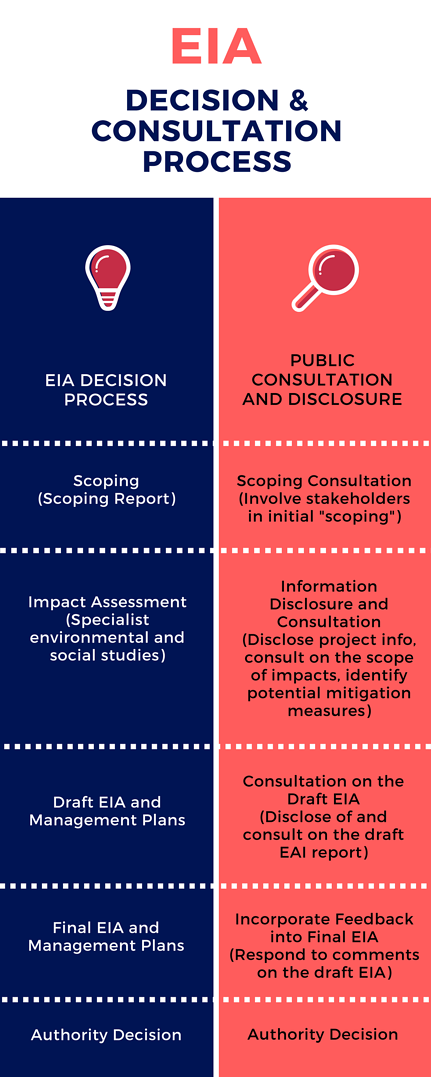Public Consultation in Impact Assessment
“Public consultation in EIA” is a topic generating a lot of questions. I decided to put together a brief introduction of the EIA consultation process, its key elements and some good practice pointers. I hope it helps answer some basic questions that you may have. Check out our ebooks and other blog posts for more tips on how to implement a successful consultation process.
What is EIA/ESIA?
An Environmental Impact Assessment (EIA) or Environmental and Social Impact Assessment (ESIA/ SEIA) is a process of identifying environmental and social risks and impacts of a project. The assessment follows applicable laws and regulations of the jurisdictions in which the project operates.
Risks and impacts are analysed in the context of the area of influence for key stages of the project development.
The EIA also proposes mitigation and performance improvement measures and actions that address the identified risks and impacts ( often called the management program).
A good assessment is based on appropriate environmental and social baseline data, an accurate project description, and of course, specialists with sound environmental and social background and experience.
Not all projects require an EIA as part of project planning and approval. An EIA is more likely necessary for a large-scale project with diverse and signification environmental and social impacts. Smaller-scale projects (defintion varied in different countries) may find that they are exempt from regulatory requirements for an EIA.
When to consult?
The most intense period of planned public participation will likely take place during the feasibility and EIA process, which will help determine whether or not to proceed (by the project proponent, their sponsors, and the regulator) with the new project. Most information about stakeholder concerns, issues, and opportunities are often collected from targeted consultation directed related to the EIA studies.
The flowchart below shows a typical decision process for an EIA and corresponding public disclosure and consultation program. Note that while ‘Scoping’ exercise is mandatory in many jurisdictions (such as in the USA and Canada), it is a voluntary step in the EIA process in many countries, Australia included. Nonetheless, best practice guidelines sugguest that EIA scoping is an important step to help identify more accurately the full range of potential impacts from a project.


Typical Public Consultation and Disclosure Program for an EIA
The essential elements of public consultation in EIA
- Forward planning the community engagement with a schedule and sufficient resources. Prepare a Public Consultation and Disclosure Plan to guide engagement activities during the period of main EIA studies.
- Placing consultation efforts on stakeholders most affected by the project, either because of their proximity to the project or their vulnerability to change.
- Incorporating stakeholder feedback into EIA findings and mitigation measures to reduce risks and impacts and increase local social and economic benefits. Closing the consultation loop by letting the community know how their views and feedback have influenced project designs and decisions.
Good practice tips on EIA public participation
- Systematically identify stakeholders and their interests. Undertake stakeholder mapping to inform the EIA Public Consultation and Disclosure Plan.
- Early consultation with stakeholders (from the project concept phase) helps set a positive tone for conversations with the affected people about the potential impacts of the project and proposed mitigation measures. Don’t wait until the EIA process starts to have the first contact with the affected community.
- Involve stakeholders in the scoping phase to identify the stakeholder’s greatest concerns about the project development. This is to ensure that the EIA takes full account of the priority concerns of the key stakeholders and more accurately identifies the full range of potential impacts.
- Seek stakeholder input in how they wish to be consulted and incorporate this into the consultation plan.
- Prepare a Public Consultation and Disclosure Plan proportionate to project impacts.
- Disclose relevant and understandable project information ahead of any consultation so the affected population have time to digest it before being consulted on issues that affect their lives.
- Employ good practice consultation. Click here to see what a good practice consultation process looks like. Read my free-ebook Seven Steps to Successful Consultation for more tips on how to implement a successful public consultation process.
- Document the process and the results of consultation.
- Inform the stakeholders about the evolving changes in the project designs regularly.
- Ensure community feedback is fed through to all specialist studies so their issues and concerns can be addressed and their suggestions can be evaluated to either incorporated or rejected with clear rationale communicated back to the community.
- Disclose the draft EIA and management plans in appropriate locations that are readily available to the affected population, and notify stakeholders on how they can access and provide comments on them.
- Respond to comments on draft EIA. Develop a mechanism for receiving, documenting and addressing comments submitted.
- Provide feedback to the public on how their input has influenced the project designs and decisions.
For an example mechanism to document the process and results of EIA consultation, to receive and analyse stakeholder comments, check out Darzin stakeholder engagement software by clicking on the image below.


